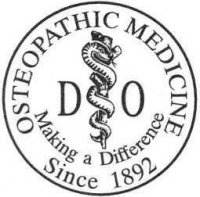

MedFriendly®


Doctor of
Osteopathic
Medicine
A Doctor of Osteopathic Medicine (often abbreviated D.O.or
DO) is a health professional that has earned a degree of
Doctor of Osteopathic Medicine after studying and
graduating from a course of study at an approved medical
school. Osteopathic medicine is an approach to healthcare
that uses common medical procedures, but it places a
greater emphasis on understanding the relationship
between the organs, muscles, nerves, tissues, bones (such
as those that surround the spine), and tendons, than
traditional medical training does.
FEATURED BOOK: Foundations of Osteopathic Medicine
HOW DOES SOMEONE BECOME A DOCTOR OF OSTEOPATHIC MEDICINE AND
WHAT DO THEY DO?
People that go to medical school to become a Doctor of Osteopathic Medicine usually
emphasized science courses when they were in college. There are four basic years of
medical school that must be completed. The medical student must pass tests known as
the National Board Examination to earn a D.O. This test is usually given in the second
year of medical school, the last year of medical school, and after medical school.
To learn more about specific osteopathic medical schools in the U.S., visit the website of
The American Association of Colleges of Osteopathic Medicine.
"Where Medical Information is Easy to Understand"™
After graduating medical school, a D.O. usually
gains additional training in a hospital for about two
years. This additional training is known as
residency or internship. After this training, the D.O.
usually begins his or her own private practice or
goes on to get additional training in a specific field
of medicine.
The length of this training will depend on the area in
which one specializes in. In order to practice
medicine, however, the D.O. needs to get a
license in the state that he/she wants to practice
in.


Someone who trains to be a D.O. focuses on osteopathic medicine during medical school. Osteopathic
medicine is an approach to medicine that uses common medical procedures, but it places a greater
emphasis on understanding the relationship between the organs, muscles, nerves, tissues, bones, and
tendons, than traditional medical training does. Tendons are groups of fibers that attach muscles to a
bone. The idea behind osteopathic medicine is that the different parts of the body are all connected in
some way and that the muscles and bones are most important to a person's well-being. D.O.'s believe that
disturbances in one system of the body can affect other systems.
A D.O. will be able to diagnose and treat medical conditions, prescribe drugs, and perform surgery.
However, due to their extra training in the muscles and bones they will be able to understand and fix
problems with structures of the body (such as bones) by using their hands (a technique known as
osteopathic manipulative treatment). For example, D.O.'s may help patients stretch their muscles or place
pressure on the joints to improve movement. A joint is a place where two bones contact each other.
D.O.'s are generally more willing to try non-prescription drugs to treat problems, such as herbs.
WHAT IS THE DIFFERENCE BETWEEN A DOCTOR OF OSTEOPATHIC MEDICINE AND A DOCTOR
OF MEDICINE?
The difference between a Doctor of Medicine (commonly abbreviated as M.D.) and a D.O. is that a D.O.
focuses on osteopathic medicine during their training, whereas an M.D. does not. See the previous
section for a description of osteopathic medicine. An M.D. completes all of the basic medical training that
a D.O does, except for the training in osteopathic medicine. It is impossible to make a general statement
as to whether an M.D. is better than a D.O. or vice versa. There are some M.D.'s that are better than
D.O.'s and there are some D.O.'s that are better than M.D.'s.
HOW LONG HAS OSTEOPATHIC MEDICINE BEEN AROUND?
Although the field of osteopathic medicine may seem new to some, it has actually been around since 1874
when it was created in Missouri by Andrew Taylor Still, who ironically was a Doctor of Medicine. As was
mentioned earlier, the idea behind osteopathic medicine is that the different parts of the body are all
connected in some way and that the muscles and bones are most important to a person's well-being.
WHAT ELSE IS A DOCTOR OF OSTEOPATHIC MEDICINE KNOWN AS?
The original term "D.O., as conceived by Dr. Andrew Taylor Still, stood for Diplomate in Osteopathy and
the degree was known as Doctor of Osteopathy. The title later came to be known as Doctor of
Osteopathic Medicine, which is the preferred term of the American Osteopathic Association (AOA). The
AOA prefers that the terms osteopathy and osteopath be reserved only for historical, sentimental, and
informal discussions. Some people consider the terms osteopathy and osteopath offensive because they
have been associated with pseudoscientific techniques by non-doctoral level professionals in countries
outside the United States. However, there are some D.O.s who still use these terms and its use is
reflected in the American Academy of Osteopathy.














